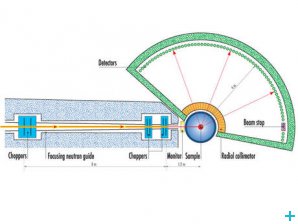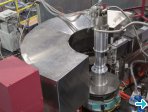How to optimise multi-channel neutron focusing guides for extreme sample environments?
NMI3 collaboration works on simulations to find the best possible guide for experiments at low temperatures and high magnetic fields.
Inês Crespo, 27/04/2015
The focusing of neutrons is important for many neutron scattering studies, particularly when samples are available in small volumes. One of the aims of the NMI3 Joint Research Activity (JRA) on Advanced Methods and Techniques is to design and build a split, multi-channel neutron focusing guide that begins focusing outside a cryomagnet and completes the focusing optic within the extreme sample environment apparatus. This guide has two physically separate sections and together with a cryomagnet will be used to expose samples to low temperatures and high magnetic fields.
To evaluate the performance of two possible guide designs the team conducted Monte-Carlo simulations coupled with optimisation algorithms. The three algorithms used to assess the guide’s performance were artificial bee colony (ABC), differential evolution (DE), and particle-swarm optimisation (PSO). These algorithms are population-based, which evolve over time towards the best solution for a certain design scenario. In this case, a good performance means that a higher number of neutrons reached the sample at the end of the focusing guide. A particular curiosity is that these algorithms are inspired by nature, such as by the behaviour of social animals like the flocking of birds, and can exhibit superior performance for neutronic optimisation problems compared to traditional algorithms. The optimisation methods were compared with each other for two different guide designs at the IN5 spectrometer at the Institute Laue-Langevin (ILL).
This allowed them to find the best possible guide that suits their needs. The team concluded that the best performance is achieved with the three-channel focusing guide, to which ABC and DE found the best guide designs. With the three-channel focusing guide more than the double of the neutrons reach the sample as compared to having no focusing guide. As for the single-channel guide, PSO and DE performed the best. According to the team it is beneficial to investigate several different optimisation routines when designing focusing guides.
The results of the initial optimisation study were very satisfactory. This design is capable of extreme vertical focusing elements crossing into a sample environment system. Neutron scattering experiments in extreme conditions will soon beneficiate from using these guides!
Original Publication
D D DiJulio, E Lelièvre-Berna, P Courtois, K H Andersen and P M Bentley (2014) Optimization of multi-channel neutron focusing guides for extreme sample environments. Journal of Physics: Conference Series 528 doi:10.1088/1742-6596/528/1/012006
NMI3 thanks Douglas Di Julio for reviewing this article.
Latest NMI3 highlights
Neutrons unveil a promising alternative for natural gas storage and transportation
Thanks to NMI3 support, for the first time researchers create artificial methane hydrates in just a few minutes. Read more.
Superstructure in Heusler alloys discovered
Scientists determine the structure of shape memory alloys of nickel-manganese-indium. They have received NMI3 support to conduct experiments at MLZ through the Rapid Access Program. Read more.
Will we have stronger, enduring teeth? New material for tooth fillings is being investigated
Scientists used neutrons and X-rays to better understand the structure and hydration process of glass ionomer cements. This material is a promising alternative for dental fillings. Read more.




